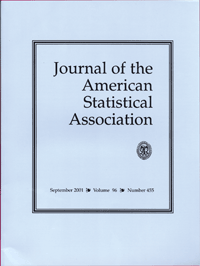Changes in Store for Future Issues
David Banks, Dalene Stangl, and Len Stefanski
 At the Joint Statistical Meetings, the ASA Board of Directors voted that all ASA journals will move to make electronic publication their primary medium. This will not obviate the current system, in which hard copy journals are delivered to all those who subscribe, but it will allow authors to make full use of color in the electronic version and to write their papers using language that refers to color. (Color is expensive to produce, requiring special inserts, so authors are discouraged from using it unless it is essential.)
At the Joint Statistical Meetings, the ASA Board of Directors voted that all ASA journals will move to make electronic publication their primary medium. This will not obviate the current system, in which hard copy journals are delivered to all those who subscribe, but it will allow authors to make full use of color in the electronic version and to write their papers using language that refers to color. (Color is expensive to produce, requiring special inserts, so authors are discouraged from using it unless it is essential.)
The move to electronic primacy opens the door to broader service to ASA members. For example, the board noted that in an electronic system, there can be access to accepted papers before hard copy publication, which helps in getting the word out on new research results. (JASA typically has a backlog of at least one issue.) Also, it will be possible to include dynamic graphics as part of a JASA paper (the hard copy will have a high-resolution static grayscale figure with a note that the reader should access the online version for motion). Also, it will be possible for subscribers to be alerted when, according to their individual preferences, articles are accepted on specific topics or by specified authors.
As part of this transformation, subscribers will soon be receiving quarterly emails with links to articles in the current issue. Thus, JASA subscribers will receive both hard copy and electronic delivery of their journal (unless they are among those who have opted out of hard copy, in which case the quarterly emails will constitute the only delivery system).
The editors feel these changes are a step forward in providing improved service to subscribers and to ASA members in general. The staging of these changes is being worked out, but prospective authors should plan now to use color and expect immediate access once the galleys have been finalized.
Applications and Case Studies
This section contains its usual diversity of applications. Regarding elections, Ben Hansen and Jake Bowers write about an analysis that attributes effects to a cluster-randomized get-out-the-vote campaign. On health status studies, Rebecca Hubbard, Lurdes Inoue, and Paula Diehr develop a joint model for self-rated health and physical functioning. And for ecology, Nicole Augustin et al. study spatio-temporal trends in forest health monitoring data.
Cancer topics are addressed in three papers, each of which addresses a different facet of the disease. Jianhua Hu, Xuming He, Gilbert Cote, and Ralf Krahe analyze microarray data. Guosheng Yin and Ying Yuan provide a Bayesian model averaging structure that improves on current methods for dose-finding and apply this to cancer therapy data. And Carolyn Rutter, Diana Miglioretti, and James Savarino develop Bayesian calibration for microsimulation models of cancer event histories.
This does not begin to exhaust the range of applications in this issue, nor does this short catalog do justice to the authors. It is an exciting collection of papers, and showcases the broad impact of our field.
Theory and Methods
This section opens with the JSM JASA (T&M) invited paper. Motivated by applications in dietary science, R. J. Carroll, A. Delaigle, and P. Hall present interesting and surprising results in “Nonparametric Prediction in Measurement Error Model.” Additional insights and extensions of the work appear in four discussions by J. Fan and Y. Feng, S. Schennach, J. Staudenmayer, and J. Sun and X. Wang.
Moving from the subtleties of measurement cheap ativan for sale error to the realities of large-scale inferences, Brad Efron writes “Empirical Bayes Estimates for Large-Scale Prediction Problems.” Bayesian contributions include “The Multiset Sampler,” by S. C. Leman, Y. Chen, and M. Lavine, and “Nonparametric Bayes Modeling of Multivariate Categorical Data,” by D. B. Dunson and C. Xing.

















